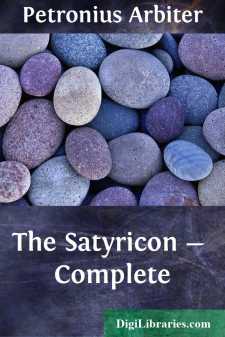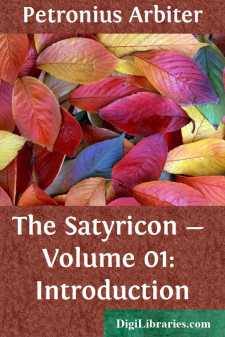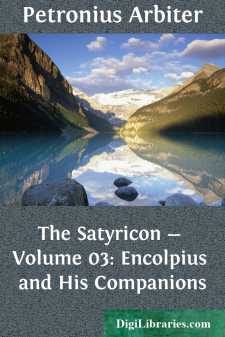Categories
- Antiques & Collectibles 13
- Architecture 36
- Art 48
- Bibles 22
- Biography & Autobiography 813
- Body, Mind & Spirit 142
- Business & Economics 28
- Children's Books 17
- Children's Fiction 14
- Computers 4
- Cooking 94
- Crafts & Hobbies 4
- Drama 346
- Education 46
- Family & Relationships 57
- Fiction 11829
- Games 19
- Gardening 17
- Health & Fitness 34
- History 1377
- House & Home 1
- Humor 147
- Juvenile Fiction 1873
- Juvenile Nonfiction 202
- Language Arts & Disciplines 88
- Law 16
- Literary Collections 686
- Literary Criticism 179
- Mathematics 13
- Medical 41
- Music 40
- Nature 179
- Non-Classifiable 1768
- Performing Arts 7
- Periodicals 1453
- Philosophy 64
- Photography 2
- Poetry 896
- Political Science 203
- Psychology 42
- Reference 154
- Religion 513
- Science 126
- Self-Help 84
- Social Science 81
- Sports & Recreation 34
- Study Aids 3
- Technology & Engineering 59
- Transportation 23
- Travel 463
- True Crime 29
The Satyricon - Complete
Description:
Excerpt
Of the many masterpieces which classical antiquity has bequeathed to modern times, few have attained, at intervals, to such popularity; few have so gripped the interest of scholars and men of letters, as has this scintillating miscellany known as the Satyricon, ascribed by tradition to that Petronius who, at the court of Nero, acted as arbiter of elegance and dictator of fashion. The flashing, wit, the masterly touches which bring out the characters with all the detail of a fine old copper etching; the marvelous use of realism by this, its first prophet; the sure knowledge of the perspective and background best adapted to each episode; the racy style, so smooth, so elegant, so simple when the educated are speaking, beguile the reader and blind him, at first, to the many discrepancies and incoherences with which the text, as we have it, is marred. The more one concentrates upon this author, the more apparent these faults become and the more one regrets the lacunae in the text. Notwithstanding numerous articles which deal with this work, some from the pens of the most profound scholars, its author is still shrouded in the mists of uncertainty and conjecture. He is as impersonal as Shakespeare, as aloof as Flaubert, in the opinion of Charles Whibley, and, it may be added, as genial as Rabelais; an enigmatic genius whose secret will never be laid bare with the resources at our present command. As I am not writing for scholars, I do not intend going very deeply into the labyrinth of critical controversy which surrounds the author and the work, but I shall deal with a few of the questions which, if properly understood, will enhance the value of the Satyricon, and contribute, in some degree, to a better understanding of the author. For the sake of convenience the questions discussed in this introduction will be arranged in the following order:
1. The Satyricon.
2. The Author.
a His Character.
b His Purpose in Writing.
c Time in which the Action is placed.
d Localization of the Principal Episode.
3. Realism.
a Influence of the Satyricon upon the Literature of the World.
4. The Forgeries.
I
THE SATYRICON.
Heinsius and Scaliger derive the word from the Greek, whence comes our English word satyr, but Casaubon, Dacier and Spanheim derive it from the Latin 'satura,' a plate filled with different kinds of food, and they refer to Porphyrion's 'multis et variis rebus hoc carmen refertum est.'
The text, as we possess it, may be divided into three divisions: the first and last relate the adventures of Encolpius and his companions, the second, which is a digression, describes the Dinner of Trimalchio. That the work was originally divided into books, we had long known from ancient glossaries, and we learn, from the title of the Traguriensian manuscript, that the fragments therein contained are excerpts from the fifteenth and sixteenth books. An interpolation of Fulgentius (Paris 7975) attributes to Book Fourteen the scene related in Chapter 20 of the work as we have it, and the glossary of St. Benedict Floriacensis cites the passage 'sed video te totum in illa haerere, quae Troiae halosin ostendit (Chapter 89), as from Book Fifteen. As there is no reason to suppose that the chapters intervening between the end of the Cena (Chapter 79) and Chapter 89 are out of place, it follows that this passage may have belonged to Book Sixteen, or even Seventeen, but that it could not have belonged to Book Fifteen. From the interpolation of Fulgentius we may hazard the opinion that the beginning of the fragments, as we possess them (Chapters 1 to 26), form part of Book Fourteen. The Dinner of Trimalchio probably formed a complete book, fifteen, and the continuation of the adventures of Encolpius down to his meeting with Eumolpus (end of Chapter 140) Book Sixteen. The discomfiture of Eumolpus should have closed this book but not the entire work, as the exit of the two principal characters is not fixed at the time our fragments come to an end. The original work, then, would probably have exceeded Tom Jones in length.
a--"Not often," says Studer (Rheinisches Museum, 1843), "has there been so much dispute about the author, the times, the character and the purpose of a writing of antiquity as about the fragments of the Satyricon of Petronius." The discovery and publication of the Trau manuscript brought about a literary controversy which has had few parallels, and which has not entirely died out to this day, although the best authorities ascribe the work to Caius Petronius, the Arbiter Elegantiarum at the court of Nero. "The question as to the date of the narrative of the adventures of Encolpius and his boon companions must be regarded as settled," says Theodor Mommsen (Hermes, 1878); "this narrative is unsurpassed in originality and mastery of treatment among the writings of Roman literature....









